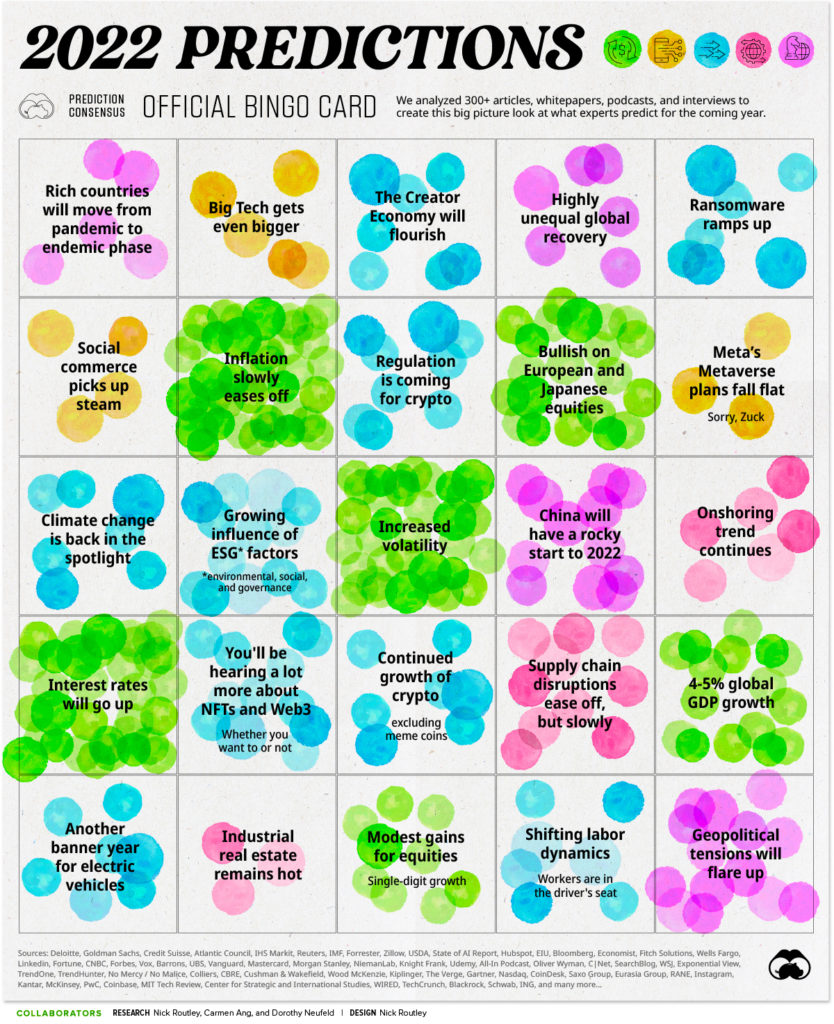
Visual Capitalist published its review of expert predictions for 2022. While we could spend time arguing over whether each specific prediction is likely or not, what is clear is that disruption is here to stay.
If even a small portion of the predictions on the bingo card come to pass, 2022 is likely to be challenging for business leaders, and the world as a whole. Not only will they have to address each individual trend, such as shifting labour dynamics or the creator economy flourishing, but the emergent impacts of these trends as they impact on one another. It is those unpredictable related and intertwined outcomes that will cause disruption and uncertainty. How senior teams handle this ongoing disruption and the resulting unexpected consequences depends on how adaptive they are strategically.
When businesses look ahead as part of their strategic planning, they often look at predictions for the coming years, like those identified in the Visual Capitalist bingo card, to determine how the business will move ahead toward its strategic goals. The senior team may decide to defend the company against the potential impacts of the trend on their business. Or, they may decide, on the contrary, to take advantage of the trend to gain new markets, higher revenue or more customers. Whether in defence or towards realising growth, there will be some activity designed to deliver the response they have determined.
Looking at the Visual Capitalist bingo card, the senior team may focus on the macroeconomic picture as that has the most impact on their profits. In modelling out the impact of interest rates going up and inflation easing up, they may identify specific changes that they want to make to their finances. For example, they may decide to take on debt now before the interest rates rise, comfortable that, even if they hold the money for a period of time while setting up some capital investment or acquisition, its value will not erode as much with inflation easing up.
The issue is these are not the only trends taking place in the business’ environment. It is more likely that most of the topics on the bingo card will be in play, even if the individual predictions do not come to pass.
To return to our example, if global recovery is highly unequal, with rich countries moving toward having endemic Covid, as opposed to pandemic, and there is a shifting labour dynamic, how does that impact interest rates, inflation and the ability of the business to execute the acquisition or capital investment they are planning? What about the growing influence of ESG factors on the plans? If the team attempts to model out the various scenarios and score their likelihood, the exercise could become unmanageable very quickly.
This is the nature of disruption: complex, unpredictable interactions amongst a range of different events. Disruption is complex because there are many different interrelated factors impacting the business today and into a fast evolving future (with even less certainty). It is also complex in that these trends are playing out on different levels: global, regional and by sector. This makes the dynamics of the interaction more unpredictable.
If disruption makes prediction difficult, if not impossible, what can business leaders do? They can shift their focus toward making their business more adaptable strategically. This involves a transformation in how leaders think, plan and communicate.
The first step is to accept that operating in disrupted markets is business as usual and a different environment that requires different tools. The certainty that comes from predictability, based on experience, goes out the door. In its place there are best guesses, hedged bets and a focus on resilience. This requires senior teams to be more humble and open to different perspectives. Strategies become hypotheses to be tested and refined, or abandoned, in the face of unexpected events and accelerating change
Strategic adaptability leads to a different kind of planning, much closer to agile development methodologies than traditional project management. Projects are iterative and include multiple feedback loops in order to adjust or redefine the project.
As a result, strategic review and planning becomes a constant leadership activity, instead of a periodic activity outside the core day-to-day management activities. As a team, business leaders are engaged with both operational leadership and strategic insight. If there is a hypothesis that a particular scenario will emerge, then we are looking at the results of the actions that we are taking and whether or not it proves the hypothesis. If the hypothesis is being proved wrong, the leadership team can then formulate a new one based on the results.